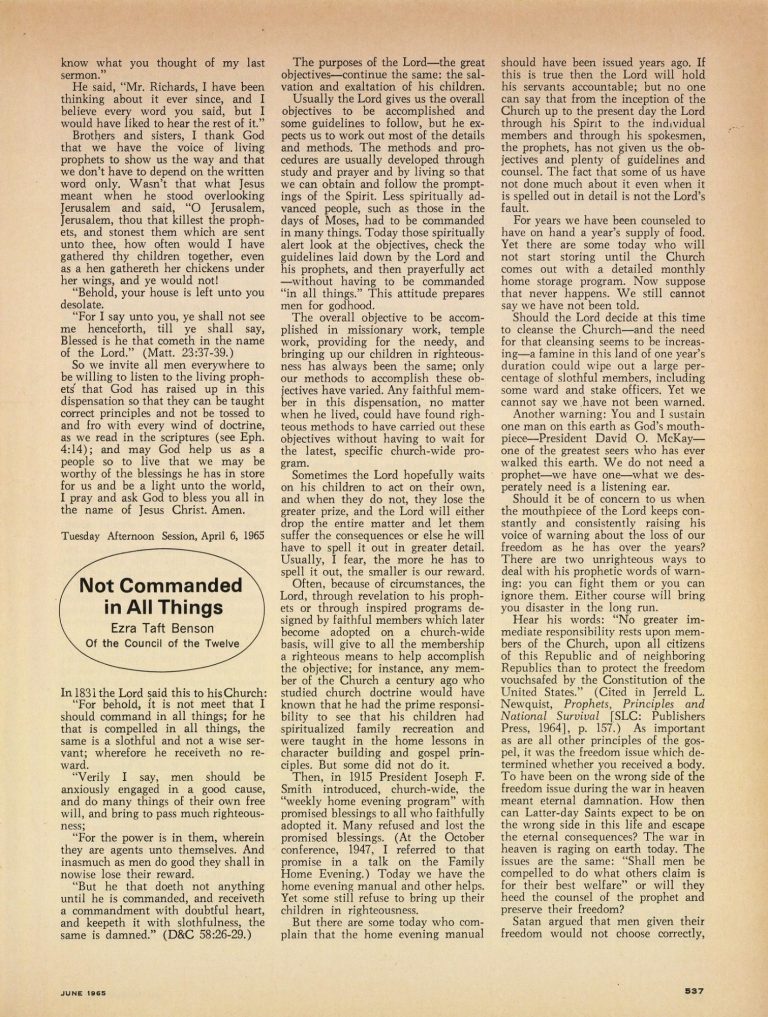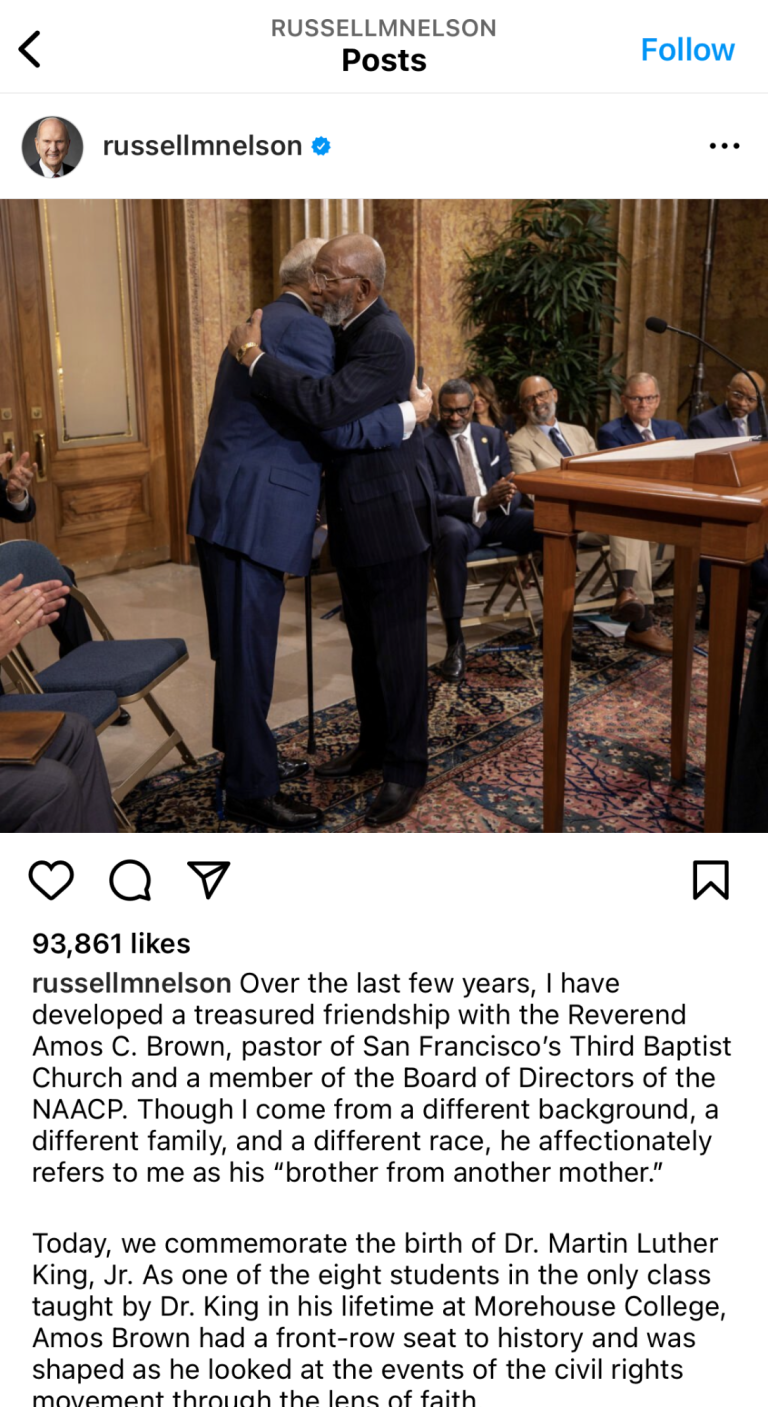Dr. Martin Luther King Jr.
1960s
What did the Mormon leaders think of Dr Martin Luther King Jr. and the Civil Rights movement in the 60s?
“I do not feel that a man can be a Christian and a staunch segregationist simultaneously.”
Martin Luther King Jr. "Advice for Living" 1957

Elder Benson
April 1965 General Conference
In his April 1965 General Conference address that was later edited, Elder Benson stated:
“Before I left for Europe I warned how the communists were using the civil rights movement to promote revolution and eventual takeover of this country. When are we going to wake up? What do you know about the dangerous civil rights agitation in Mississippi!”
Washington Post
13 April 1965
Less than two weeks later Benson’s speech was covered in a Washington Post article headlined “Benson Ties Rights Issue to Reds in Mormon Rift.” (April 13, 1965).
[The image presented here is NOT the 1965 edition. I don't have access to the article, but the image stands as representation]
The article is referenced in D. Michael Quinn's "Ezra Taft Benson and Mormon Political Conflicts" on page 35.]
The article is also referenced in the Sunstone article titled "Very Careless in His Utterances: Editing, Correcting, and Censoring Conference Addresses–Part II"


Benson's talk edited
In the same Sunstone article, the author goes on to say:
"Benson’s talk made the national spotlight on 13 April 1965, when his speech was covered in a Washington Post article headlined “Benson Ties Rights Issue to Reds in Mormon Rift.” In a meeting of the First Presidency on 23 April, Hugh B. Brown [pictured on the left] called attention to the negative publicity generated by the Washington Post article and the unfavorable reactions he was hearing about Benson’s remarks. McKay’s initial reaction was that he “had not noticed anything objectionable in what Brother Benson had said.” McKay then asked Brown to bring him “a report” of the talk, and Brown told him “he would do it at once.” Later in the meeting, N. Eldon Tanner told McKay that he had also “received telephone calls and letters” about Benson’s talk.
On 3 May, in a meeting between McKay and Brown, McKay “authorized the elimination” of the ...two paragraphs from Benson’s talk" presented above.
Ezra Taft Benson
"Ezra Taft Benson: An Enemy Hath Done This" by Jerrold L. Newquist, 1969
"Would anyone deny that the President [Lyndon Johnson], the chief law enforcer in the United States, belies his position by playing gracious host to the late Martin L. King who has preached disobedience to laws which in his opinion are unjust?"


Ezra Taft Benson
"Ezra Taft Benson: An Enemy Hath Done This" by Jerrold L. Newquist, 1969
"The man who is generally recognized as the leader of the so-called civil rights movement today in America is a man who has lectured at a Communists training school, who has solicited funds through Communist sources, who hired a Communist as a top-level aide, who has affiliated with Communist fronts, who is often praised in the Communist press and who unquestionably parallels the Communist line. This same man advocates the breaking of the law and has been described by J. Edgar Hoover as 'the most notorious liar in the country.' . . ."
John Birch Society
The John Birch Society Bulletin for October 1965 also referred to civil rights activists and Martin Luther King as "the animals."
While not an official member of the society, Ezra Taft Benson praised the John Birch Society as "the most effective non-church organization in our fight against creeping socialism and Godless Communism." [Sean Wilentz. "Confounding Fathers: The Tea Party's Cold War Roots". The New Yorker. October 18, 2010]. Benson requested permission of church president McKay to join the JBS and sit on its board, but the request was denied.
In 1968, the John Birch Society (JBS) made an effort to nominate Benson as a presidential candidate, with segregationist Senator Strom Thurmond as vice president, for which Benson sought and obtained approval from LDS Church president David O. McKay.


Russell M. Nelson
Instagram post
2022 Instagram Post
I like to think that my friend Amos and I are, in a very small way, the embodiment of Dr. King’s vision that people from different backgrounds and races can “sit down together at the table of brotherhood.”
I reiterate what is taught in the Book of Mormon that “black and white, bond and free, male and female; … all are alike unto God” (2 Nephi 26:33). May God continue to bless us as we labor together to lead out in abandoning attitudes and actions of prejudice.
Book of Mormon teachings
2 Nephi 5:21
Would Russell M. Nelson reiterate other teachings in the Book of Mormon? Specifically those taught in 2 Nephi that God cursed people because of their iniquity and "that they might not be enticing unto my people the Lord God did cause a skin of blackness to come upon them."

© Copyright. All rights reserved.
We need your consent to load the translations
We use a third-party service to translate the website content that may collect data about your activity. Please review the details in the privacy policy and accept the service to view the translations.